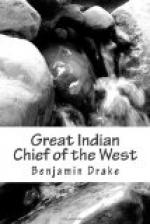The tribes of Indians on the Mississippi, were notified in the early part of this year, 1815, that peace had been concluded between the United States and England. Most of those who had been engaged in the war, ceased hostilities. Black Hawk, however, and his band, and some of the Pottawatamies, were not inclined to bury the tomahawk. Even as late as the spring of 1816, they committed depredations. Some palliation for these outrages may be found in the fact, that the British, on the north-west frontier, long after they were officially notified of the peace, continued to excite the Indians to acts of violence against the United States; and, indeed, participated in them likewise. It was in the spring of this year that they captured the garrison at Prairie du Chien, and instigated Black Hawk and his party to attack some boats, which were ascending the Mississippi to that point, with troops and provisions. In this attack, Black Hawk was the leader. One of the boats was captured and several of the crew killed. They were compelled to return, and dropped down to the fort at the mouth of the Des Moyens river. As a reward for their attack upon these boats, the British agents distributed rum among the Indians engaged in the affair, and joined with them in dancing and feasting.
In May, Black Hawk and his party, having been again summoned by the Americans, to make peace, concluded to descend the Mississippi to Portage des Sioux, to meet the American commissioners who were there for that purpose. On the 13th of May, 1816, a treaty of peace was signed by Clark, Edwards, and Choteau on behalf of the United States, and the chiefs and warriors of the Sacs of Rock river and the adjacent country. To this treaty Black Hawk was a party. It recognizes the validity of the treaty of St. Louis, of November 1804.
CHAPTER IV.
Building of Fort Armstrong—The good Spirit of Rock Island—Death of Black Hawk’s children—Young Sac offers to die in place of his brother—Black Hawk’s visit to Malden—Whipped by some whites—Whites settle at his village—Black Hawk’s talk with Governor Coles and Judge Hall—Sale of the lands on Rock river—Indians ordered to remove—Agreement to remove for six thousand dollars—Memorial of the white settlers to Governor Reynolds—The Governor’s letters to General Clark and General Gaines—The latter leaves Jefferson Barracks with six companies of the United States troops for Rock Island—His interview with Black Hawk—Calls upon the Governor of Illinois for militia—The Indians abandon their village—treaty of peace made with them—Official letters to the war department—Summary of the causes which brought on this disturbance—Black Hawk’s attempt to form an alliance with other tribes.




